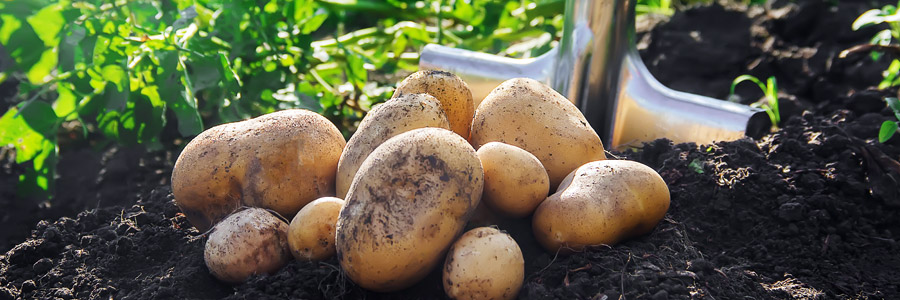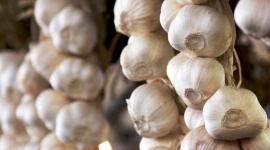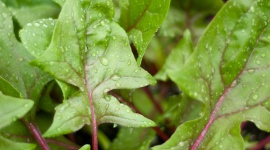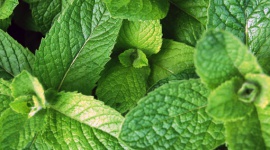Grow it yourself: Potato
Potatoes were first domesticated in western South America, in Peru and Bolivia, between 7,000-10,000 years ago, where they were such a beloved staple that local ceramicists immortalised them in potato-shaped vessels and vases. Thought to have been introduced into Europe by pirate/privateer Sir Francis Drake, among others, potatoes slowly but surely spread across the continent and, thanks to their high nutritional value and ease of storage, led to population explosions in several countries by the eighteenth century, and are even credited with helping to fuel England's Industrial Revolution.

When potatoes came to China during the Ming Dynasty, it immediately became a delicacy of the Imperial Family, and today the country leads the world in potato production, growing over 99 million tonnes of the veggie in 2016. So nourishing are these hardy ground-dwellers, that there have been times when they've literally been worth their weight in gold! During the Alaskan Klondike gold rush of 1897-98, it's rumoured that people would trade gold nuggets for a single grimy tuber.
Family ties
Potatoes are part of the nightshade family—which also includes tomatoes, capsicums, and eggplants—and like these veggies, potato leaves and stems can be poisonous if consumed in large quantities or if the tuber has turned green.
There are over 5,000 different varieties of potato in the world, and almost all of them are descended from the original species that was domesticated in the lowlands of Peru. The most familiar varieties in Australia include Kipfler, Desiree and Sebago, but there are hundreds of other types available—it is Australia's largest vegetable crop by far.
Eat me
There are countless ways to cook with spuds—in fact, it might be quicker to list the things they don't go well in. (Although we can't actually think of any!) From chocolate cake to vodka, potatoes really are incredibly versatile, and there's a different variety to suit every recipe you can think of. Waxy, new season potatoes (check to see if the skin can be scraped off with a fingernail to test their freshness) are great in soups and salads, while starchy varieties like King Edward and Dutch Cream are perfect for mash, roasts and chips.
Grow me
Potatoes are so easy to grow they'll sprout in zero gravity! They were famously the first veggie to be grown in space, which really makes the daily trek out to the veggie patch pale in comparison.

In Australia, potatoes should be planted between September and February in cool and temperate areas, and March and August in the hot north. They need quite a lot of space (and depth), so a dedicated bed is great, or grab some polystyrene fruit boxes and stack them up to create a vertical space (tires are a no no because of toxic chemicals that can leak into the soil).
Once you've decided on the location, mix compost with well-aged manure and straw to a depth of 15 cm, water, then lay the spuds out with 25 cm between them and cover with another 15 cm of the soil mix. When sprouts poke through, add another 15cm, then do it once more when the sprouts come through again. Make sure you get good quality, disease-free seeding potatoes and expose them to light for a week or so before planting to get the eyes ready to sprout.
When the leaves begin to yellow (between 12-20 weeks depending on the variety), it's time to harvest your new taters, and as all the leaves die down you can root around for the big boys and pack them carefully away in a cool, dark place for months.
Feed me
If you've prepared the soil well (aim for a PH between 5.5-6), potatoes shouldn't need much extra food (except perhaps some liquid seaweed at planting and flowering), and it's important not to overwater, as this leads to a raft of diseases that can wipe out your crop in a jiffy.
Growing tips
- Make sure your soil is well drained—wet soil will cause tubers to rot!
- Once you've harvested mature potatoes, allow them to 'cure' for a week or two. 'Curing' involves brushing off most of the dirt, then spreading the spuds out away from the sunlight until their skins harden, before storing in a cool, dark, well-ventilated spot.
- Potatoes shouldn't be grown in the same spot two seasons in a row—rotate your potato bed with leafy greens or beans for at least a couple of years before replanting with spuds.
- Beans, legumes, basil, parsley and thyme are good potato companions, increasing nitrogen levels in the soil and welcoming beneficial insects (and are also said to enhance flavour!)
- Avoid planting potatoes with its nightshade relatives (tomatoes, capsicums etc) as well as cucumbers, pumpkins, raspberries and sunflowers.

Cure what ails ya'
Although potatoes have developed a bad reputation in recent times, it's ill-deserved, and when they're not doused in oil and salt, they are a remarkably healthy veggie. High in fibre, with more potassium than a banana and over 40% of your daily recommended intake of Vitamin C, potatoes are also packed with antioxidants (especially the skins!). Properly prepared, they are great for gut health and can reduce blood pressure, cholesterol, and blood sugar levels.
Garlicky spuds
Ingredients
- 500 grams of new (freshly dug!) potatoes
- 4 finely chopped garlic cloves
- 50 gm butter
- 25 ml extra virgin olive oil
- ½ bunch finely chopped flat-leaf parsley
- Handful of finely chopped chives
- Sea salt and freshly ground pepper
Method
- Rub the skin off the new potatoes
- Bring them to a boil in salted water until tender, then drain
- Return pot to heat and add oil and butter
- Add potatoes and garlic and sauté until just crispy
- Stir through herbs, salt and pepper
- Enjoy!



